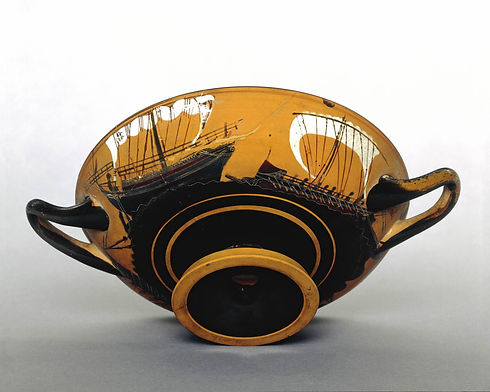SAILING THE SEVEN SEAS
Greece is a country surrounded by water and the sea has always played an important role in its history. The ancient Greeks were active seafarers seeking opportunities for trade and founding new independent cities at coastal sites across the Mediterranean Sea. By the seventh and sixth centuries BCE, Greek colonies and settlements stretched all the way from western Asia Minor to southern Italy, Sicily, North Africa, and even to the coasts of southern France and Spain. As a powerful naval force in the latter part of the sixth and fifth centuries BCE, Athens exerted its influence over sea trade.

THE ARGO
The Argo was built by Argus with the help of the goddess Athena. The ship was built from the wood of a tree felled in the magical forest of Dodona. Dodona was a sacred area in ancient Greece, a region linked with the god Zeus and with prophecy. The Oracle of Dodona was considered second only to the Oracle of Delphi in the ancient world. So, using oak from the sacred forest imbued the Argo with mystical powers. The ship was said to be able to speak and to offer up prophecies of its own.
There has been much discussion, both in antiquity and more recently, as to the type of ship the Argo would have been. It is said the Argo was a ‘ship to sail the seas’ which may indicate that the Argo was a galley that would have been large enough to traverse the open ocean.
The simplest of the early Greek galleys were monoremes, which only had a single bank of oarsmen along each side of the ship. It is estimated that there were 50 Argonauts sailing the Argo. This tells us that the Argo was likely a monoreme penteconter with 50 oars.

KNOW THY SHIP
There were many different types of ships during the 5th-4th centuries BCE. Warships called war galleys included: penteconter, biremes and triremes. There were also smaller boats used for patrolling harbours. The much larger polyremes of ancient Carthage, Rome and Egypt were not common in the Greek Classical world. The Greeks favoured smaller classes of ships that were highly manoeuvrable and swift, in comparison to larger, heavier ships. Smaller ships also had the benefit of being able to navigate smaller river systems with their shallow keels and shorter hull lengths.
Ships designed for the transportation of goods, people and animals were also widely used. They were often repurposed war galleys with a reduced oar-crew to allow for more storage space.

A SAILOR'S LIFE
On Athenian navy ships, the rowers made up the bulk of the crew. They were a mix of conscripted citizens and volunteers who came from the lowest class of Athenian citizens known as the Thetes.
If crews needed additional numbers, foreign mercenaries could be hired from other city-states or Greek islands. Although popular in movies, it was not common for slaves to be used as rowers in the navy. They were only used when there were few other options; such as the closing years of the Peloponnesian Wars, and the following 4th century when Athens was struggling economically. However, depictions of the lower level of an ancient ship as very cramped and hot is correct, and the oarsmen's work was very strenuous and demanding. As a result, a rower would likely have worn little more than a loincloth to cover his lower half.
